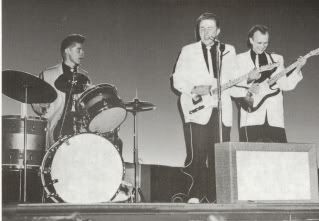
Phil Humphrey, center, and Jim Sundquist,
right, added drummer Johnny Hauer to the Fendermen
when they performed with Johnny Horton in Sault Ste.
Marie,Mich. in early May 1960.
By STEVE SEYMOUR
The Fendermen, known for the massively-popular "Mule Skinner Blues," weren't from the Upper Peninsula, but they are closely tied to the area.
Comprised of Phil Humphrey (vocals, rhythm guitar) and Jim Sundquist (lead guitar), the duo's novelty song grabbed the public's attention in 1960.
Sundquist hailed from Niagra, Wis., just across the Michigan border from neighboring Iron Mountain and Kingsford.
Early publicity in the music trade magazine Billboard erroneously stated Sundquist was from Iron Mountain, although some shows may have been booked from that Dickinson County community. Other sources claim Kingsford as Sundquist's birthplace.
In addition to that geographical kinship, the Fendermen played one of their most noteworthy shows in the eastern U. P. city of Sault Ste. Marie.
Coincidentally, both musicians were born on Nov. 26, 1937. As a teenager, Sundquist took up the guitar and played in a local band, graduating from Niagra High School in 1955. Meanwhile, Madison, Wis. native Humphrey started singing at age eight and had his own band by the time he was a junior in high school.
The two met at a party in Milwaukee and later started playing together, calling themselves the Fendermen after the famous brand of guitars they used.
They learned a variety of cover material including "Mule Skinner Blues." Also known as "Blue Yodel #8," the song was written and recorded by country star Jimmie Rodgers in 1930.
The duo played a number of small gigs in the Madison area, where their version of the old number was wildly received by audiences.
Wherever Humphrey sang "Good morning, captain. Good morning to you, son. Do you need another muleskinner on your new mud line," the reaction was the same.
At one performance, the Fendermen were approached by record store owner William Dreger who encouraged them to wax the song for a possible single.
Consequently, the Fendermen taped "Mule Skinner Blues" and the original instrumental "Janice" (a tribute to Sundquist's wife) in Dreger's basement.
Dreger's tape eventually made its way to Jim Kirchstein who recently opened Cuca Studio in Sauk City, Wis. Kirchstein saw promise in the record, which became one of the first releases on the fledgling label. 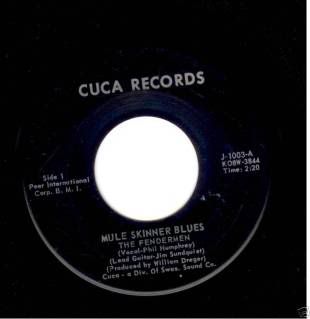
Despite being a hit in concert, radio stations were slow to add the record to their playlists until Lindy Shannon spun the disc on WKBH in LaCrosse, Wis.
Demand for the record exploded from that humble beginning, but Cuca couldn't get additional copies manufactured quick enough.
With a hot commodity on their hands, an agreement was made to bring the Fendermen to Soma Records in Minneapolis where they re-recorded "Mule Skinner Blues" at Kay Bank Studios. The song was paired with the original instrumental "Torture" as Soma 1137.
Co-founded by Amos and Dan Heilicher in 1957, Soma issued Bobby Vee's first hit, garnering the marketing expertise to push "Mule Skinner Blues" up the charts.
A few weeks after their trip to Minneapolis, the Fendermen had enough notoriety to launch them on a year-long tour.
Their first "big-time" show took place at Sault Ste. Marie in May, 1960.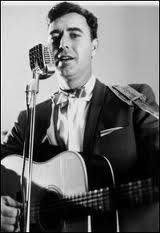
They weren't headliners, but opened for Johnny Horton, famous for "The Battle of New Orleans" and "Sink the Bismarck."
The Fendermen added drummer Johnny Hauer to their line-up to fill-out their live sound.
Despite their excitement at sharing the stage with Horton, the Fendermen were in for a bigger thrill when they were named as an "extra added attraction" for a show at the Minneapolis Auditorium on May 15, 1960. On this occasion, Horton was second billed to Johnny Cash, while the city's disc jockeys were giving "Mule Skinner Blues" heavy airplay.
On Saturday, June 11, the Fendermen played their hit on "American Bandstand," Dick Clark's coast-to-coast television program.
Billboard feted them in their "Discourse" column in the June 13 magazine: "The Fendermen are a new duo on the scene making it with a fast climber on Billboard's Hot 100, 'Mule Skinner Blues.' Jim Sundquist, from Iron Mountain, Mich., and Phil Humphrey, from Madison, Wis., make up the Fendermen. With a solid musical background-- Phil had a rock and roll band for three years-- the boys are off to a good record start on Soma Records."
The following week the magazine ran a brief article, "Fendermen Score Via 'Mule Skinner Blues'," complete with a photo of the pair. "The boys are currently making personal appearances around the country," the publication noted.
At mid-summer, "Mule Skinner Blues" charted as high as No. 5.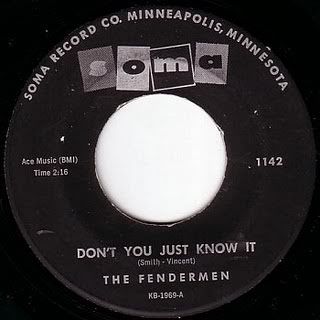
In August, Soma ran a full-page advertisement promoting the Fendermen's next single, "Don't You Just Know It," backed by an original instrumental titled "Beach Party."
Billboard recognized the disc as "Spotlight Winner of the Week," saying: "The instrumental-vocal combo is just coming off a strong hit in 'Mule Skinner Blues' and this reprise of an earlier Huey Smith smash, which is handled with crazy sound and laughter, can repeat. Watch it."
Soma encouraged disc jockeys to send for free copies and stocked its 37 distributors with the product, including JayKay Distribution of Detroit.
Minneapolis booking agent T. B. Skarning arranged for the group to tour the western United States beginning with Pocatello, Idaho on Aug. 22 and ending Sept. 2 in Colorado Springs, Colo.
The Fendermen gigged in Los Angles from Aug. 26 to 28, Sundquist remembering playing with the Ventures, who were riding high with "Walk--Don't Run."
Despite the publicity push, the Fendermen's second single only managed to crack the "Bubbling Under" section of the Hot 100 chart.
Billboard reported in Sept. that rocker Gene Vincent ("Be-Bop-A-Lula") was on tour in Alaska, accompanied by the Fendermen.
In the magazine's Mar. 13, 1961 issue, Soma ran just a small display ad to announce the Fendermen's third 45 rpm disc, "Heartbreakin' Special"/ "Can't You Wait." Billboard predicated: "The Fendermen could jump back on the charts with these strong sides. Top side is a driving train song sung with gusto by Phil Humphrey. Flip is pretty ballad." The record garnered few sales and little airplay despite the positive comments.
Weeks later the Fendermen were touring Canada with the Fireballs ("Bulldog") and Buddy Knox ("Party Doll"), Billboard reported.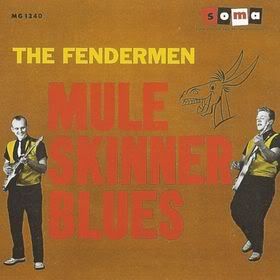
Although the Fendermen can be classified as one-hit wonders, Soma did follow-up with a 12-track LP in 1962, which came too late to capitalize on the success of "Mule Skinner Blues."
That same year Sundquist and Humphrey amicably dissolved their partnership and Soma Records settled a lawsuit with the tiny Cuca label, ending a dispute regarding payment for leasing the first recording of the hit song two years before.
"Mule Skinner Blues" is still played on radio today, keeping alive a recording which has sold an estimated 4,500,000 copies worldwide. Not bad for a little duo from the upper midwest, eh?
###

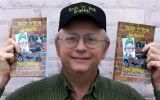
 I've enjoyed rock music and writing since I was a teenager in the 60s. I feel lucky to have been around when rock's greatest stars created their most enduring hits. At the same time I found I enjoyed writing, as well. I worked on my high school newspaper and magazine, was editor of several college publications and earned a bachelor's degree from Central Michigan University in 1973. I worked for the daily newspaper in my hometown after graduating, becoming managing editor after a few years. By the 1980s, I moved into public relations. In 1985, my wife Sue and I opened a retail music store, The Record Rack, which we still own. Rock 'n' roll has been integral to me and for the last 2O years I've been earning my living from it even though I don't have a musical bone in my body. In recent years, I've also I edited a small local magazine and launched a micro FM radio station. Now, I'm finally combining my love of writing and rock 'n' roll. I can't sing a note, but I know what I like. I'll tell you all about it when you read on. I hope you have as much enjoyment reading these installments as I've had writing them.
I've enjoyed rock music and writing since I was a teenager in the 60s. I feel lucky to have been around when rock's greatest stars created their most enduring hits. At the same time I found I enjoyed writing, as well. I worked on my high school newspaper and magazine, was editor of several college publications and earned a bachelor's degree from Central Michigan University in 1973. I worked for the daily newspaper in my hometown after graduating, becoming managing editor after a few years. By the 1980s, I moved into public relations. In 1985, my wife Sue and I opened a retail music store, The Record Rack, which we still own. Rock 'n' roll has been integral to me and for the last 2O years I've been earning my living from it even though I don't have a musical bone in my body. In recent years, I've also I edited a small local magazine and launched a micro FM radio station. Now, I'm finally combining my love of writing and rock 'n' roll. I can't sing a note, but I know what I like. I'll tell you all about it when you read on. I hope you have as much enjoyment reading these installments as I've had writing them.


No comments:
Post a Comment